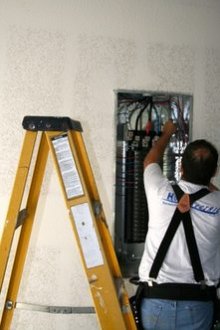 Electricians’ employment opportunities are expected to grow approximately 12 percent from 2008 to 2018. The United States Bureau of Labor Statistics projects increased building construction that includes electrical work. The Bureau also anticipates that older buildings’ electrical systems will need upgrades to meet new electrical codes. Electricians will also be needed to install new energy-saving systems in many buildings. Finally, more electricians will be sought to replace workers who are expected to retire.
Electricians’ employment opportunities are expected to grow approximately 12 percent from 2008 to 2018. The United States Bureau of Labor Statistics projects increased building construction that includes electrical work. The Bureau also anticipates that older buildings’ electrical systems will need upgrades to meet new electrical codes. Electricians will also be needed to install new energy-saving systems in many buildings. Finally, more electricians will be sought to replace workers who are expected to retire.
Step 1
Structure your electrical business. Choose your business structure with the aid of a Certified Public Accountant familiar with small service businesses. Visit your city or county clerk’s office to obtain a business license, and inquire about additional permits required in your jurisdiction. Consult with a commercial insurance agent about business liability and professional liability insurance. Finally, ask your state Department of Revenue if you need a sales tax number for your service business. The Houston One Stop Business Center notes that the city of Houston does not require a general business license, although surrounding towns may require their own licenses. Professional licenses must be obtained separately (See Resources).
Step 2
Handle your electrician licensing logistics. Before you can operate as a professional electrician or electrical contractor, you’ll need a state-issued license. Contact your state’s electrical licensing department, or general professional licensing board, regarding applicable tests and licenses. In Texas, you must have a valid professional license from the Texas Department of Licensing and Regulation. Licenses are issued to different classes of electricians, and to electrical contractors. Individual electricians or businesses may apply (See References).
Step 3
Establish your base of operations. If you’ll spend most of your time servicing customers, a small office will likely be sufficient. You’ll need a secure space in which to store your electrical supplies, and a workbench to perform needed wiring assembly work. Finally, you'll need secure parking for a work van stocked with electrical equipment and supplies.
Step 4
Cultivate your commercial prospects. Contact general contractors to discuss potential electrical opportunities in new home construction or remodeling projects. Inquire about commercial construction projects, such as office buildings, assisted living facilities and other commercial buildings.
Step 5
Recruit real estate business. Contact area real estate companies, and offer your services to agents whose clients need electrical services. Electrical work is sometimes needed to prepare a home for the real estate market, or to comply with recommendations issued by a home inspector. Agents who don’t currently need your services will appreciate the available expertise, and may provide referrals to colleagues.
Step 6
Attract residential remodelers. Homeowners commonly hire licensed electricians to complete the electrical phase of home remodeling projects. Attract this residential business by offering a discount on electrical project fees for a limited period of time. Work with a graphics designer to create a colorful ad that spotlights these savings. Place your ad in home improvement guides inserted in local newspapers, and reinforce your message by repeating the ad in the newspaper’s home section.
Things Needed
- Business license
- Local permits (if applicable)
- Business liability insurance information
- Professional liability insurance information
- Sales tax number information (if applicable)
- Professional electrical license
- Lease
- List of general contractors
- List of real estate companies and agents
- Information for color ad
- Ad rates and copy for Home Improvement Guides



